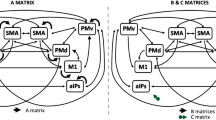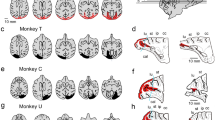Abstract
Adaptive motor behavior requires efficient error detection and correction. The posterior parietal cortex is critical for on-line control of reach-to-grasp movements. Here we show a causal relationship between disruption of cortical activity within the anterior intraparietal sulcus (aIPS) by transcranial magnetic stimulation (TMS) and disruption of goal-directed prehensile actions (either grip size or forearm rotation, depending on the task goal, with reaching preserved in either case). Deficits were elicited by applying TMS within 65 ms after object perturbation, which attributes a rapid control process on the basis of visual feedback to aIPS. No aperture deficits were produced when TMS was applied to a more caudal region within the intraparietal sulcus, to the parieto-occipital complex (putative V6, V6A) or to the hand area of primary motor cortex. We contend that aIPS is critical for dynamic error detection during goal-dependent reach-to-grasp action that is visually guided.
This is a preview of subscription content, access via your institution
Access options
Subscribe to this journal
Receive 12 print issues and online access
$209.00 per year
only $17.42 per issue
Buy this article
- Purchase on Springer Link
- Instant access to full article PDF
Prices may be subject to local taxes which are calculated during checkout






Similar content being viewed by others
References
Johnson, S.H. & Grafton, S.T. From 'acting on' to 'acting with': the functional anatomy of object-oriented action schemata. Prog. Brain Res. 142, 127–139 (2003).
Marconi, B. et al. Eye-hand coordination during reaching. I. Anatomical relationships between parietal and frontal cortex. Cereb. Cortex 11, 513–527 (2001).
Rizzolatti, G. & Matelli, M. Two different streams form the dorsal visual system: anatomy and functions. Exp. Brain Res. 153, 146–157 (2003).
Luppino, G., Murata, A., Govoni, P. & Matelli, M. Largely segregated parietofrontal connections linking rostral intraparietal cortex (areas AIP and VIP) and the ventral premotor cortex (areas F5 and F4). Exp. Brain Res. 128, 181–187 (1999).
Rizzolatti, G. & Luppino, G. The cortical motor system. Neuron 31, 889–901 (2001).
Taira, M., Mine, S., Georgopoulos, A.P., Murata, A. & Sakata, H. Parietal cortex neurons of the monkey related to the visual guidance of hand movement. Exp. Brain Res. 83, 29–36 (1990).
Sakata, H., Taira, M., Murata, A. & Mine, S. Neural mechanisms of visual guidance of hand action in the parietal cortex of the monkey. Cereb. Cortex 5, 429–438 (1995).
Murata, A., Gallese, V., Luppino, G., Kaseda, M. & Sakata, H. Selectivity for the shape, size, and orientation of objects for grasping in neurons of monkey parietal area AIP. J. Neurophysiol. 83, 2580–2601 (2000).
Sakata, H. et al. Neural coding of 3D features of objects for hand action in the parietal cortex of the monkey. Phil. Trans. R. Soc. Lond. B Biol. Sci. 353, 1363–1373 (1998).
Sakata, H. et al. Neural representation of three-dimensional feature of manipulation of objects with stereopsis. Exp. Brain Res. 128, 160–169 (1999).
Murata, A., Gallese, V., Kaseda, M. & Sakata, H. Parietal neurons related to memory-guided hand manipulation. J. Neurophysiol. 75, 2180–2186 (1996).
Gallese, V., Murata, A., Kaseda, M., Niki, N. & Sakata, H. Deficit of hand preshaping after muscimol injection in monkey parietal cortex. Neuroreport 5, 1525–1529 (1994).
Binkofski, F. et al. Human anterior intraparietal area subserves prehension. Neurology 50, 1253–1259 (1998).
Binkofski, F. et al. A fronto-parietal circuit for object manipulation in man: evidence from an fMRI-study. Eur. J. Neurosci. 11, 3276–3286 (1999).
Culham, J.C. et al. Visually guided grasping produces fMRI activation in dorsal but not ventral stream brain areas. Exp. Brain Res. 153, 180–189 (2003).
Johnson-Frey, S., Vinton, D., Newman-Norlund, R. & Grafton, S.T. Cortical topography of human anterior intraparietal cortex active during visually-guided grasping. Brain Res. Cogn. Brain Res. (in the press).
Pisella, L. et al. An 'automatic pilot' for the hand in human posterior parietal cortex: toward reinterpreting optic ataxia. Nat. Neurosci. 3, 729–736 (2000).
Gréa, H. et al. A lesion of the posterior parietal cortex disrupts on-line adjustments during aiming movements. Neuropsychologia 40, 2471–2480 (2002).
Desmurget, M. et al. Role of the posterior parietal cortex in updating reaching movements to a visual target. Nat. Neurosci. 2, 563–567 (1999).
Morand, S. et al. Electrophysiological evidence for fast visual processing through the human koniocellular pathway when stimuli move. Cereb. Cortex 10, 817–825 (2000).
Foxe, J.J. & Simpson, G.V. Flow of activation from V1 to frontal cortex in humans: A framework for defining “early” visual processing. Exp. Brain Res. 142, 139–150 (2002).
Rodriguez-Fornells, A., Kurzbuch, A.R. & Münte, T.F. Time course of error detection and correction in humans: Neurophysiological evidence. J. Neurosci. 22, 9990–9996 (2002).
Schroeder, C.E., Mehta, A.D. & Givre, S.J. A spatiotemporal profile of visual system activation revealed by current source density analysis in the awake macaque. Cereb. Cortex 8, 575–592 (1998).
Martinez, A. et al. Putting spatial attention on the map: timing and localization of stimulus selection processes in striate and extrastriate visual areas. Vision Res. 41, 1437–1457 (2001).
Paulignan, Y., Jeannerod, M., MacKenzie, C. & Marteniuk, R. Selective perturbation of visual input during prehension movements. 2. The effects of changing object size. Exp. Brain Res. 87, 407–420 (1991).
Castiello, U., Bennett, K.M. & Stelmach, G.E. Reach to grasp: the natural response to perturbation of object size. Exp. Brain Res. 94, 163–178 (1993).
Jeannerod, M. Coordination mechanisms in prehension movements. in Tutorials in Motor Behavior II. Advances in Psychology Vol. 87 (eds. Stelmach, G.E. & Recquin, J.) 265–286 (Elsevier, New York, 1992).
MacKenzie, C.L. & Iberall, T. The grasping hand. in Advances in Psychology Vol. 104 (eds. Stelmach, G. & Vroon, P.) 162–166 (Elsevier, New York, 1994).
Clower, D.M., Dum, R.P. & Strick, P.L. Basal ganglia and cerebellar inputs to 'AIP'. Cereb. Cortex advance online publication, 30 September 2004 (10.1093/cercor/bhh190).
Smith, M.A., Brandt, J. & Shadmehr, R. Motor disorder in Huntington's disease begins as a dysfunction in error feedback control. Nature 403, 544–549 (2000).
Desmurget, M. et al. On-line motor control in patients with Parkinson's disease. Brain 127, 1755–1773 (2004).
Tunik, E., Adamovich, S.V., Poizner, H. & Feldman, A.G. Deficits in rapid adjustments of movements according to task constraints in Parkinson's disease. Mov. Disord. 19, 897–906 (2004).
Tunik, E., Poizner, H., Adamovich, S.V., Levin, M.F. & Feldman, A.G. Deficits in adaptive upper limb control in response to trunk perturbations in Parkinson's disease. Exp. Brain Res. 159, 23–32 (2004).
Della-Maggiore, V., Malfait, N., Ostry, D.J. & Paus, T. Stimulation of the posterior parietal cortex interferes with arm trajectory adjustments during the learning of new dynamics. J. Neurosci. 24, 9971–9976 (2004).
Glover, S., Miall, R.C. & Rushworth, M.F. Parietal rTMS disrupts the initiation but not the execution of on-line adjustments to a perturbation of object size. J. Cogn. Neurosci. 17, 124–136 (2005).
Johnson, S.H. et al. Selective activation of a parieto-frontal circuit during implicitly imagined prehension. Neuroimage 17, 1693–1704 (2002).
Anderson, R.A. & Buneo, C.A. Sensorimotor integration in posterior parietal cortex. in Advances in Neurology. The Parietal Lobes Vol. 93 (eds. Siegel, A.M., Anderson, R.A., Freund, H.-J. & Spencer, D.D.) 159–177 (Lippincott Williams & Wilkins, New York, 2003).
Monzee, J. & Smith, A.M. Responses of cerebellar interpositus neurons to predictable perturbations applied to an object held in a precision grip. J. Neurophysiol. 91, 1230–1239 (2004).
Shikata, E. et al. Surface orientation discrimination activates caudal and anterior intraparietal sulcus in humans: an event-related fMRI study. J. Neurophysiol. 85, 1309–1314 (2001).
Shikata, E. et al. functional properties and interaction of the anterior and posterior intraparietal areas in humans. Eur. J. Neurosci. 17, 1105–1110 (2003).
Saito, D.N., Okada, T., Morita, Y., Yonekura, Y. & Sadato, N. Tactile-visual cross-modal shape matching: a functional MRI study. Brain Res. Cogn. Brain Res. 17, 14–25 (2003).
Sakata, H., Taira, M., Kusunoki, M., Murata, A. & Tanaka, Y. The TINS Lecture. The parietal association cortex in depth perception and visual control of hand action. Trends Neurosci. 20, 350–357 (1997).
Galletti, C., Fattori, P., Kutz, D.F. & Battaglini, P.P. Arm movement-related neurons in the visual area V6A of the macaque superior parietal lobule. Eur. J. Neurosci. 9, 410–413 (1997).
Galletti, C., Kutz, D.F., Gamberini, M., Breveglieri, R. & Fattori, P. Role of the medial parieto-occipital cortex in the control of reaching and grasping movements. Exp. Brain Res. 153, 158–170 (2003).
Zangaladze, A., Epstein, C.M., Grafton, S.T. & Sathian, K. Involvement of visual cortex in tactile discrimination of orientation. Nature 401, 587–590 (1999).
Battaglini, P.P. et al. Effects of lesions to area V6A in monkeys. Exp. Brain Res. 144, 419–422 (2002).
Acknowledgements
S.H. Frey was formerly S.H. Johnson. P. Schmitt provided critical technical assistance. This work was supported by Public Health Service grant NS044393 to S.T.G.
Author information
Authors and Affiliations
Corresponding author
Ethics declarations
Competing interests
The authors declare no competing financial interests.
Rights and permissions
About this article
Cite this article
Tunik, E., Frey, S. & Grafton, S. Virtual lesions of the anterior intraparietal area disrupt goal-dependent on-line adjustments of grasp. Nat Neurosci 8, 505–511 (2005). https://doi.org/10.1038/nn1430
Received:
Accepted:
Published:
Issue Date:
DOI: https://doi.org/10.1038/nn1430
This article is cited by
-
Left anterior supramarginal gyrus activity during tool use action observation after extensive tool use training
Experimental Brain Research (2023)
-
A kinematic and EMG dataset of online adjustment of reach-to-grasp movements to visual perturbations
Scientific Data (2022)
-
The characterization of actions at the superordinate, basic and subordinate level
Psychological Research (2022)
-
Are metaphors embodied? The neural evidence
Psychological Research (2022)
-
Perturbation of cortical activity elicits regional and age-dependent effects on unconstrained reaching behavior: a pilot study
Experimental Brain Research (2021)



